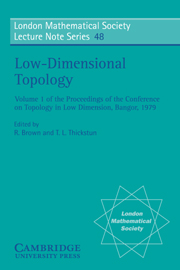The universal abelian cover of a link
Published online by Cambridge University Press: 05 October 2010
Summary
Introduction
Given a Seifert surface for a classical knot, there is associated a linking form from which the first homology of the infinite cyclic cover may be obtained. This article considers classical links of two components and shows how to obtain a pair of linking forms from the analogue of a Seifert surface. From these the first homology of the universal abelian (ℤ ⊕ ℤ) cover is obtained, thus giving a practical method for calculating the Alexander polynomial. Also obtained is a new signature invariant for links. The method generalises to links of any number of components; however this is not done here.
In this paper, unless otherwise stated, a link will mean a piecewise-linear embedding of two oriented circles in the three sphere S3. The main results are (2.1) and (2.4). The former provides a square matrix presenting the first homology of the cover obtained from the Hurewicz homomorphism of the link complement. The latter gives a signature invariant, obtained from this matrix, which vanishes for strongly slice links. On the way some known results are obtained, namely Torres' conditions on a link polynomial, and a result of Kawauchi and independently Nakagawa on the (reduced) Alexander polynomial of a strongly s1ice 1ink.
The paper is organised as follows. Section 2 contains the method of obtaining the matrix used in (2.1) and states the main results. The reader not interested in the proofs need read no further.
- Type
- Chapter
- Information
- Low-Dimensional Topology , pp. 51 - 66Publisher: Cambridge University PressPrint publication year: 1982
- 14
- Cited by



